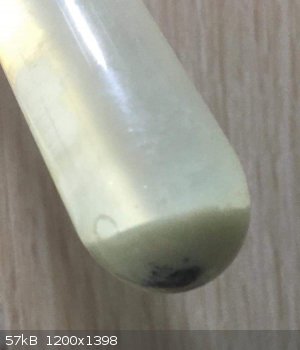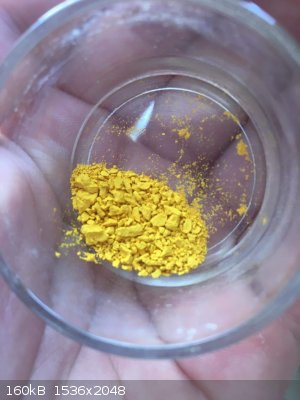vano
National Hazard
   
Posts: 661
Registered: 22-3-2019
Location: Georgia
Member Is Offline
|
|
How to separate Bismuth from lead and tin?
Hi. i have rose's metal and does it possible to separate Bismuth from them?
http://www.sciencemadness.org/talk/viewthread.php?tid=157392
|
|
|
vano
National Hazard
   
Posts: 661
Registered: 22-3-2019
Location: Georgia
Member Is Offline
|
|
Okay, i made it. I dissolved alloy in conc. Nitric acid, i used excess metal, then i added water and insoluble Bismuth oxynitrate was formed. From
oxynitrate i will make Bismuth oxide.
|
|
|
Infamous_Reddy
Harmless

Posts: 13
Registered: 25-2-2019
Location: Southern India
Member Is Offline
Mood: Variable
|
|
You could separate them by considering the reactivity series of metals.
First, increase the surface area of the alloy to increase the rate of reaction as metal displacement reaction can often take hours. Then, take a sol.
of any soluble Antimony compound (which doesn't hydrolyse in water) and put the alloy in the sol. As the Antimony is more reactive than the Bismuth
but less so than the Lead and Zinc, the antimony should slowly precipitate while the Pb and Sn slowly displace the Sb. After several hours, almost all
of the Lead and Zinc should be dissolved. Then, you can add nitric acid to convert them into their nitrate salts and add glycerol. Work with it as
soon as possible as Bi(NO3)3 decomposes into BiONO3. Bismuth nitrate is soluble in glycerol but the solubility of antimony nitrate is very slight. After the Antimony nitrate precipitates, filter it. Reduce the nitrate back to bismuth metal by
aluminium foil or any other reducing agents.
You could also vacuum distill the Rose metal if you have access to that. That is much less tedious and less time-consuming.
|
|
|
vano
National Hazard
   
Posts: 661
Registered: 22-3-2019
Location: Georgia
Member Is Offline
|
|
Thanks, interesting method. That is problem for me, because I don't have much antimony source, but i have lots of azeotropic nitric acid and i will
use it.
|
|
|
Bedlasky
International Hazard
    
Posts: 1219
Registered: 15-4-2019
Location: Period 5, group 6
Member Is Offline
Mood: Volatile
|
|
If you dissolve it in HNO3, tin precipitates as SnO2. In the solution will be Bi(NO3)3 and Pb(NO3)3, which you can separate by hydrolysis of bismuth
nitrate as you suggest.
|
|
|
vano
National Hazard
   
Posts: 661
Registered: 22-3-2019
Location: Georgia
Member Is Offline
|
|
Thanks Bedlasky, i forgot to say that. When i dissolved alloy in nitric acid, Solution wasn't clear, it had white colour, then white powder
precipitated. as you mentioned this is a SnO2, next filtered Solution contains soluble nitrates.
This is precipitated oxide and excess metal(yellowish colour is because of light).

|
|
|
symboom
International Hazard
    
Posts: 1143
Registered: 11-11-2010
Location: Wrongplanet
Member Is Offline
Mood: Doing science while it is still legal since 2010
|
|
Next would be separating lead nitrate from the bismuth nitrate. It looks like sodium plumbate is soluble and sodium bismuthate is insouble but
becareful these are very powerful oxidizers.
|
|
|
Bedlasky
International Hazard
    
Posts: 1219
Registered: 15-4-2019
Location: Period 5, group 6
Member Is Offline
Mood: Volatile
|
|
Sodium bimusthate(V) can't be made in this way. What would oxidize Bi(III) to Bi(V)? Nitrate? Too weak oxidiser (and we are talking about alkaline
solution, where nitrate practically don't have oxidizing properties). I doubt that you can oxidise Bi(III) to Bi(V) in aqueous solution (but in solid
state it is quite easy).
Above pH 2 bismuth form insoluble basic nitrates, while lead stay dissolved.
|
|
|
unionised
International Hazard
    
Posts: 5102
Registered: 1-11-2003
Location: UK
Member Is Offline
Mood: No Mood
|
|
Did you consider adding salt?
Lead chloride is almost insoluble.
|
|
|
vano
National Hazard
   
Posts: 661
Registered: 22-3-2019
Location: Georgia
Member Is Offline
|
|
When i had acidic solution of lead and bismuth, i precipitated they with hydroxide. Next i filtered it and dissolved lead hydroxide in hot hydroxide
solution to produce soluble Na2[Pb(OH)4]. I dissolved Bismuth hydroxide in concentrated nitric acid and added potassium dichromate concentrated
solution. The product is not very pure, but process was fun.

|
|
|
Bezaleel
Hazard to Others
  
Posts: 444
Registered: 28-2-2009
Member Is Offline
Mood: transitional
|
|
The colour does not look like the lead dichromate which I (probably) obtained here, but more like lead chromate, PbCrO4.
Could it be that you did not wash away all of your lead as plumbate so that the remaining lead caused the yellow colour of PbCrO4? And could it be
that that the SnO2 wasn't part of the reaction? In that cae you would still get a chrome yellow precipitate, but its constituents would be SnO2 and
PbCrO4.
I searched on stannic chromate, but I did not find too much serious information on it, merely automatically generated pages. It does seem to have a
CAS number, though, found here. (I don't say the compound cannot exist, but did you obtain it?)
|
|
|
vano
National Hazard
   
Posts: 661
Registered: 22-3-2019
Location: Georgia
Member Is Offline
|
|
I washed the bismuth hydroxide well. Of course there would be small amount. When I dissolved the metal in nitric acid then tin dioxide precipitated, I
have already mentioned this step above, I just did not repeat it again.
|
|
|
Bedlasky
International Hazard
    
Posts: 1219
Registered: 15-4-2019
Location: Period 5, group 6
Member Is Offline
Mood: Volatile
|
|
Bazaleel: Bismuth chromate is yellow.
|
|
|
Bezaleel
Hazard to Others
  
Posts: 444
Registered: 28-2-2009
Member Is Offline
Mood: transitional
|
|
I completely missed the step of filtering off the tin oxide. The solution you started with contained Pb(NO3)2 and Bi-nitrate or basic Bi nitrate.
So please ignore my remarks, they don' t make sense. Sorry about the confusion.
|
|
|
vano
National Hazard
   
Posts: 661
Registered: 22-3-2019
Location: Georgia
Member Is Offline
|
|
Quote: Originally posted by Bezaleel  | I completely missed the step of filtering off the tin oxide. The solution you started with contained Pb(NO3)2 and Bi-nitrate or basic Bi nitrate.
So please ignore my remarks, they don' t make sense. Sorry about the confusion. |
No problem. I dissolved alloy in azeotropic nitric acid, first tin dioxide precipitated, next i stared working on acidic solution of Bi and Pb
nitrates. There are also other way, you can make dilute solution, then bismuth oxynitrate forms, which is insoluble, but hydroxide is easier to
filter.
|
|
|